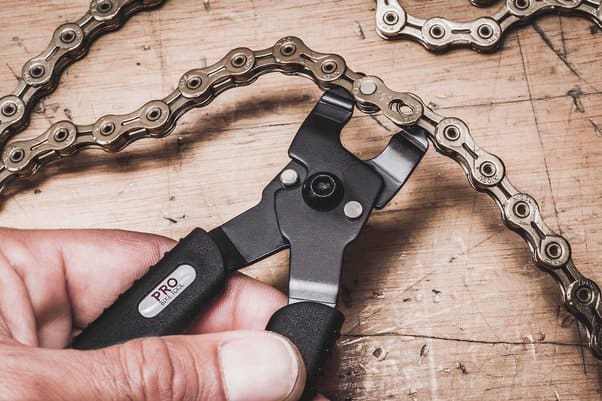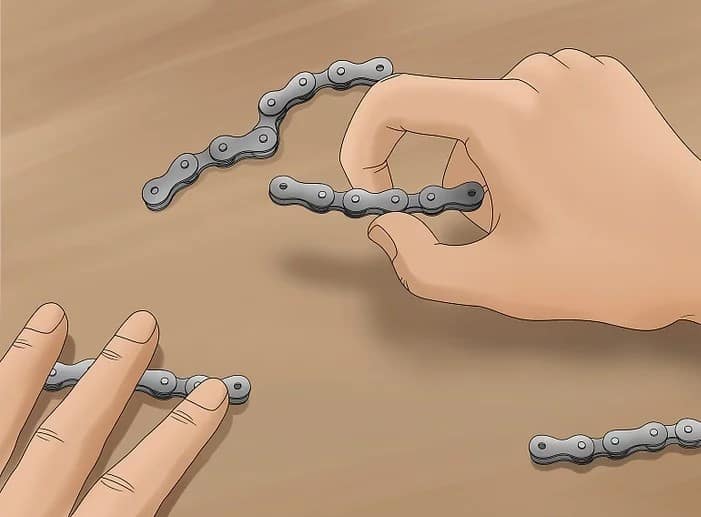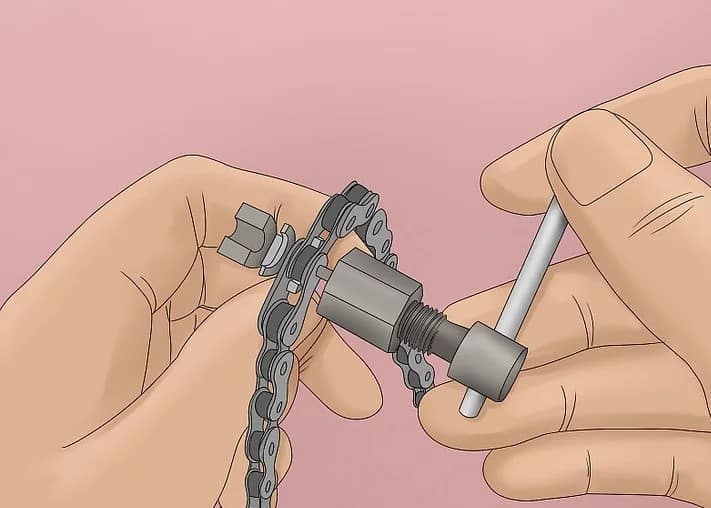
If you ride your bike for many miles, parts will wear out over time. After a lot of mileage, the bike chain “stretches” and you wonder how to remove bike chain and install a new one?
If the bike chain is new or sags significantly, it is probably too long for your bike. So you need to adjust its length first. Links also tend to stretch over time, but you don’t have to shorten the chain to solve this problem.
Trying is a sign of wear, and as soon as the value on the stretch gauge exceeds the recommended maximum, it should be changed immediately. Otherwise, you run the risk of more wear on the sprockets and broken derailleurs. And breakdowns tend to happen at the most inopportune moment.
Step 1. Determine if the chain needs to be replaced

Count off 12 links and measure their length from the first to the last pin (contact). The distance between these pins should be 30.5. If the measured distance is more than 30.80 centimeters, you need to replace the chain. This method is effective because each link is stretched as it wears out.
If the 12 link spacing is correct and you have an older bike, try loosening the rear wheel and pulling it back. This way, you can remove any slack built up after using your bike for a long time. If the distance you can move the wheel is insufficient, the chain should be shortened.
Step 2. Buy a universal chain puller if you don’t have one
A specialized bike chain removal tool is designed to make it easy to remove the chain from your bike and do any maintenance necessary.
This tool pushes out the pins so that the link can be removed. It is also called an unscrewing or squeezing tool. If you know the make and model of your bike chain, you can find a specialized tool. Also, there is a tool with a similar name to remove the chain, which has a master link. This tool is identical to pliers/cutters but with small metal “tendrils” on the ends.
Some chains, especially most higher-end Shimano and Campagnolo models, also need a particular master link to assemble them. You won’t be able to put a chain together without this master link, so make sure you have everything you need before starting the repair.
Of course, the key to any thriving repair and maintenance activity is cleaning and preparation. This step will start by gathering the tools you need to remove the bike chain. You can use a chain tool or chain breaker to help you get the chain off your bike.
With this unique tool, you can push out a rivet from your bike and start breaking the chain. Once you have all the tools you need, you are ready to clean your bike chain.
Step 3. Place your bike on a bike stand

If you don’t have a stand, lean it against something sturdy, preferably with the wheels up. Hanging it on a bike rack is ideal. This will make removing the old chain and installing the new one more accessible.
Step 4. Clean the chain if it is dirty
Use a high-quality biodegradable chain cleaner or isopropyl alcohol to dissolve dirt or grease. Cleaning will make it easier to find the master link or lock on the chain. And it will be easier and more pleasant to work with.
Step 5. Find the lock or master link

Some bike chains may or may not have a lock or the master above link. The safety is easy to spot because it is usually a little lighter/darker than the other chain links. It may also have a slightly different shape than the other links, having a special plate with a latch groove. This plate usually has an oversized oval hole around one or both pins. You will need the tool above to remove this chain, similar to pliers.
The master link is usually slightly more protruding on one side, or it has marks from previous removals. Also, if your chain doesn’t have a lock on it, you can use any link to remove it with a squeegee. And when you install it, you can either put a safety on it or leave it as it was.
Step 6. Rotate the pedals until the master link is between the front and rear sprockets

This will make it easier to access. Next, use a suitable tool from the ones we mentioned above. Open the master link out, and put it where this part is sure not to get lost. There are many designs and variations of locks. Some rotate so that the pin extends, and others open by bending. Some are also disposable and can only be removed by bending them with pliers or a unique tool.
You’ll need a chain breaker tool to remove a bike chain for cleaning or replacement. It doesn’t sound straightforward, but it’s straight. The chain breaker tool is a small press.
Check the sides of the chain to find the make and model information. Then, visit the manufacturer’s website to find information about your specific lock model.
Warning. If you don’t have a lock and are using a wrench, don’t squeeze the pin out. The edge of the pin must remain inside the “cheek” (the side of the link). Otherwise, you will find it very difficult to put it back in later and have to use another link.
In many cases, you will not be able to replace a pin if you push it entirely out of the link. However, some manufacturers (including Shimano and Campagnolo) make replacement pins, but not all are compatible with all chain models.
If you accidentally push the pin out, you may be able to guide it through the center of the link. First, use a chain tool to remove the top of the connecting link, then push the pin back through the link until the top of the pin is flush with the center of the link. Next, replace the top of the link, then use the chain tool to push it up. If necessary, adjust the adjacent pin as well.
Keep in mind that this method is “emergency” and time-consuming. Therefore, it is best not to get into this situation and ensure that the pin does not fall out of the “cheek.”

Turn the handle on the chain tool clockwise. Continue to rotate the handle until the rivet is almost out of the link. Then, turn the handle counterclockwise to pull out the chain tool pin. After that, take your chain off the chain tool and wiggle the link to pull it apart.

Step 7. Determine how many links you need to remove.
It is better to remove less at first than to remove too many. It will be easier to remove a few more links later than to add the missing links again. Remove the extra links to shorten the chain. If your goal is to compress rather than replace the chain, continue to remove excess links above. Remove the minimum number of links you need – usually less than 5. The more you shorten the chain, the more stress the connections will undergo, and consequently, the faster your chain will fail (stretch).
Step 8. Place the master link on both ends of the chain using a chain tool.
Gradually clamp the link until you feel the pins snap into the lock.
If your chain has a disposable lock or master link, you will need a replacement part to put the chain back on. Most of these special locks have two parts on opposite sides, but it’s best to look up the instructions for your particular model.
Step 9. Reconnect the chains with the chain tool.
If your chain doesn’t have a master link and you don’t want to use one (or the design won’t fit your chain model), use a pin to connect the ends. If you are using a new chain, squeeze the pin on it above and then clamp it, connecting it to the other end. To do this, place the link back into the chain squeeze slot.
Make sure the pins are facing the squeeze pin. Turn the knob counterclockwise. The chain tool pin will begin to push the master link back as you turn. Continue until you see a small portion of the same pin on the other side, ideally, if you can get this pin to align and the rest of the bike chain link. Also, it should protrude the same distance on both sides of the link.
Step 10. Move the pin if necessary.
Sometimes you will have to work the chain from side to side to move the pin and give the chain the flexibility and smoothness it needs. To do this, use both hands to grasp either side tightly and gently work the chain perpendicular to its direction of rotation until it loosens and becomes a stable cranking motion. This is called “breaking the link.” If you don’t do this, the connecting link may snap, spin badly on the stars, and get stuck in the derailleurs. This will cause the chain to wear faster.
Step 11. Apply a good quality chain lubricant to the chain.
This will increase chain life and flexibility. It will also improve shifting performance and reduce wear on derailleurs and sprockets. In addition, lubricating your chain will extend its life.
Here are a few more tips to help you take care of your iron horse
1) If you need help, don’t hesitate to go to a bike store. They will not charge you for advice and may even recommend the nearest bike club.
2) If you ride your bike regularly, check the chain every few months. The longer you delay replacing it, the more damage it will do.
3) If the chain is overtightened and challenging to remove, work the derailleurs so that the chain is on the smallest sprocket on the rear and front sprockets. This will loosen the tension and make it easier.
4) If you don’t have the correct replacement part, don’t rely on temporary solutions, and don’t try to fix the breakage/defect with improvised means. This can be frustrating if the chain breaks along the way and is dangerous in the long run.
5) Finally, check the chain for stretching more often and lubricate the entire drivetrain.
FAQs
1. How do you remove the chain from a bicycle without using a chain tool?
You have the solution to breaking chains using a hammer and needle.
2. How can you break a bicycle chain with no tools?
Removing the master tool with no chain pliers is difficult, but it’s not impossible. It would help if you modified the chain in a direction to take the master link out. However, it would help if you used the force of your hand. Again, it’s not easy and requires a lot of energy.
3. How do you remove the bike chain that isn’t breaking?
It’s nearly impossible to remove the chain from a bike with a rear derailleur. However, it is possible to take it off the bike that doesn’t have a rear derailleur if you are somewhat tricky when taking it out from the back wheel.
4. Does every bike chain come with an underlying link?
There’s no guarantee that all chains come with master links. For example, if your bicycle is equipped with derailleurs, it’s unlikely that the chain has a master link.
5. How do you fix the chain link back on the bicycle?
You’re aware of how to return the link as described above.
6. How can I eliminate the missing links without using a tool?
The use of a hammer or needle is the same in shortening the chain.
7. Are you able to place two master links on an unbroken chain?
Yes, you can. However, you must set them aside to don’t break your chain during your ride.
8. Do Shimano chains come with a master link?
KMC, YBN, SRAM, and Wippermann chains were equipped with such links for a long time. However, Campagnolo and Shimano chains remained in place and were secured using special replacement pins or rivets. Today, however, Shimano comes with chains that are master linked.
9. How can break through a chain by using the master link?
It’s as easy as pie using an instrument for chain pliers. The process is explained at the start of this article.
Conclusion
We hope you’ve learned how to take off the bike chain in various ways, even if you are lacking an essential link. However, be cautious when applying these methods. Use thick gloves to shield your hands from all kinds of injury and ensure your safety. But what if you do not have a special tool? Pay attention to this article, in which we have detailed how to remove the chain without special tools.
